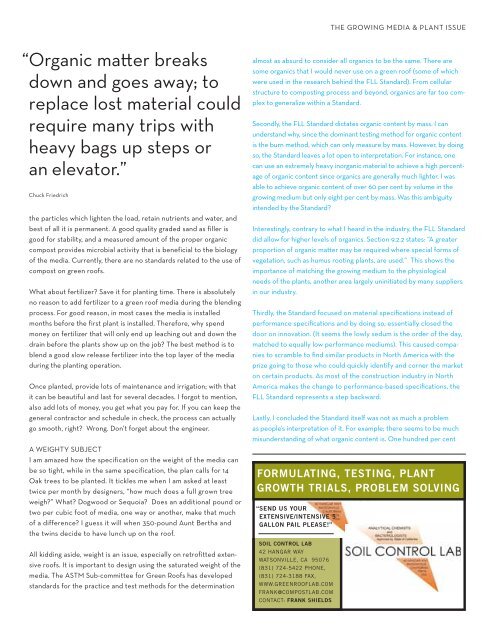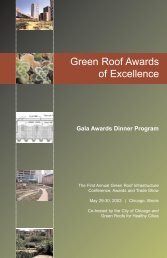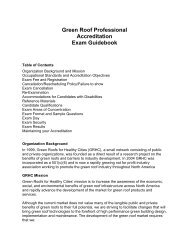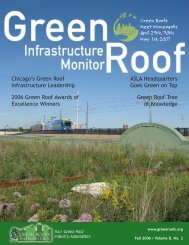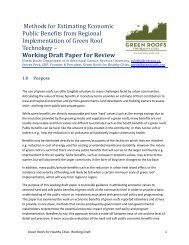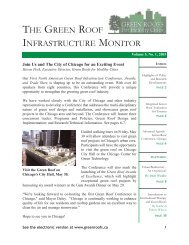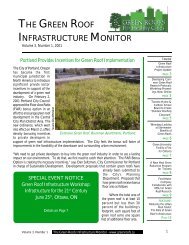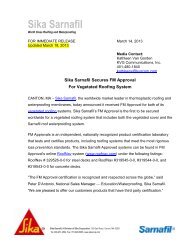Living Architecture Monitor - Green Roofs for Healthy Cities
Living Architecture Monitor - Green Roofs for Healthy Cities
Living Architecture Monitor - Green Roofs for Healthy Cities
Create successful ePaper yourself
Turn your PDF publications into a flip-book with our unique Google optimized e-Paper software.
THEGROWINGMEDIA&PLANTISSUE<br />
“Organic matter breaks<br />
down and goes away; to<br />
replace lost material could<br />
require many trips with<br />
heavy bags up steps or<br />
an elevator.”<br />
Chuck Friedrich<br />
the particles which lighten the load, retain nutrients and water, and<br />
best of all it is permanent. A good quality graded sand as filler is<br />
good <strong>for</strong> stability, and a measured amount of the proper organic<br />
compost provides microbial activity that is beneficial to the biology<br />
of the media. Currently, there are no standards related to the use of<br />
compost on green roofs.<br />
What about fertilizer? Save it <strong>for</strong> planting time. There is absolutely<br />
no reason to add fertilizer to a green roof media during the blending<br />
process. For good reason, in most cases the media is installed<br />
months be<strong>for</strong>e the first plant is installed. There<strong>for</strong>e, why spend<br />
money on fertilizer that will only end up leaching out and down the<br />
drain be<strong>for</strong>e the plants show up on the job? The best method is to<br />
blend a good slow release fertilizer into the top layer of the media<br />
during the planting operation.<br />
Once planted, provide lots of maintenance and irrigation; with that<br />
it can be beautiful and last <strong>for</strong> several decades. I <strong>for</strong>got to mention,<br />
also add lots of money, you get what you pay <strong>for</strong>. If you can keep the<br />
general contractor and schedule in check, the process can actually<br />
go smooth, right? Wrong. Don’t <strong>for</strong>get about the engineer.<br />
AWEIGHTYSUBJECT<br />
I am amazed how the specification on the weight of the media can<br />
be so tight, while in the same specification, the plan calls <strong>for</strong> 14<br />
Oak trees to be planted. It tickles me when I am asked at least<br />
twice per month by designers, “how much does a full grown tree<br />
weigh?” What? Dogwood or Sequoia? Does an additional pound or<br />
two per cubic foot of media, one way or another, make that much<br />
of a difference? I guess it will when 350-pound Aunt Bertha and<br />
the twins decide to have lunch up on the roof.<br />
All kidding aside, weight is an issue, especially on retrofitted extensive<br />
roofs. It is important to design using the saturated weight of the<br />
media. The ASTM Sub-committee <strong>for</strong> <strong>Green</strong> <strong>Roofs</strong> has developed<br />
standards <strong>for</strong> the practice and test methods <strong>for</strong> the determination<br />
almost as absurd to consider all organics to be the same. There are<br />
some organics that I would never use on a green roof (some of which<br />
were used in the research behind the FLL Standard). From cellular<br />
structure to composting process and beyond, organics are far too complex<br />
to generalize within a Standard.<br />
Secondly, the FLL Standard dictates organic content by mass. I can<br />
understand why, since the dominant testing method <strong>for</strong> organic content<br />
is the burn method, which can only measure by mass. However, by doing<br />
so, the Standard leaves a lot open to interpretation. For instance, one<br />
can use an extremely heavy inorganic material to achieve a high percentage<br />
of organic content since organics are generally much lighter. I was<br />
able to achieve organic content of over 60 per cent by volume in the<br />
growing medium but only eight per cent by mass. Was this ambiguity<br />
intended by the Standard?<br />
Interestingly, contrary to what I heard in the industry, the FLL Standard<br />
did allow <strong>for</strong> higher levels of organics. Section 9.2.2 states: “A greater<br />
proportion of organic matter may be required where special <strong>for</strong>ms of<br />
vegetation, such as humus rooting plants, are used.” This shows the<br />
importance of matching the growing medium to the physiological<br />
needs of the plants, another area largely uninitiated by many suppliers<br />
in our industry.<br />
Thirdly, the Standard focused on material specifications instead of<br />
per<strong>for</strong>mance specifications and by doing so, essentially closed the<br />
door on innovation. (It seems the lowly sedum is the order of the day,<br />
matched to equally low per<strong>for</strong>mance mediums). This caused companies<br />
to scramble to find similar products in North America with the<br />
prize going to those who could quickly identify and corner the market<br />
on certain products. As most of the construction industry in North<br />
America makes the change to per<strong>for</strong>mance-based specifications, the<br />
FLL Standard represents a step backward.<br />
Lastly, I concluded the Standard itself was not as much a problem<br />
as people’s interpretation of it. For example; there seems to be much<br />
misunderstanding of what organic content is. One hundred per cent<br />
FORMULATING, TESTING, PLANT<br />
GROWTH TRIALS, PROBLEM SOLVING<br />
“SEND US YOUR<br />
EXTENSIVE/INTENSIVE 5<br />
GALLON PAIL PLEASE!”<br />
SOIL CONTROL LAB<br />
42 HANGAR WAY<br />
WATSONVILLE, CA 95076<br />
(831) 724-5422 PHONE,<br />
(831) 724-3188 FAX,<br />
WWW.GREENROOFLAB.COM<br />
FRANK@COMPOSTLAB.COM<br />
CONTACT: FRANK SHIELDS


